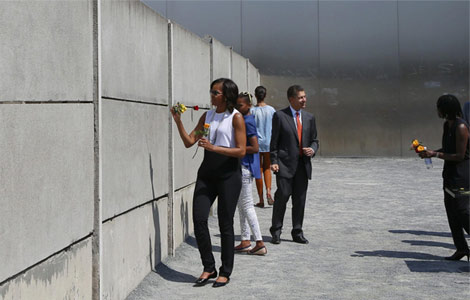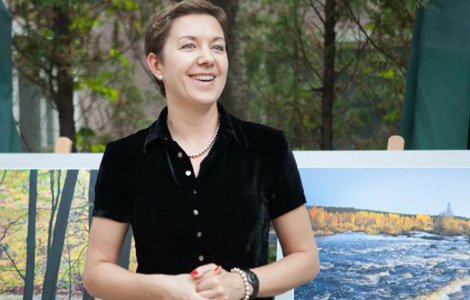A safe space to speak out
Updated: 2013-05-24 15:20
By Kelly Chung Dawson in New York (China Daily)
|
||||||||
|
The exhibition Undercurrents and the Quest for Space aims to become an outlet for female artists to speak out about the trauma of abuse, addition and other personal difficulties. Cris Matos / for China Daily |
SF exhibition gives Asian American women artists an outlet
Chinese women have often grappled with the overwhelming pressure to maintain "face", a cultural force that has led many to stay silent on issues of abuse, addiction and other personal difficulties. While any number of factors might be responsible for the increasingly high rates of suicide among Asian American women, a new exhibition seeks to provide an urgently needed outlet for artists who have faced resistance in speaking out about trauma.
Currently on display at the SOMArts Cultural Center in San Francisco through Saturday, Undercurrents and the Quest for Space features 11 Asian artists including Karen Chew, Mido Lee, Brenda Louie and Alexandra Lee. Some of the featured artists were born in the United States, with others having arrived more recently.
Organized by the Asian American Women Artists Association and the Asian Pacific Islander Cultural Center, the exhibition was curated by Inson Choy, with art selections by Asian Art Museum CEO and director Jay Xu and Mary-Ann Milford, professor of art history at Oakland's Mills College.
"Artists can play an important role as a social barometer, and it's even more critical among Asian American women that they do this because there is an underlying, culturally enforced'otherness' in these communities," said Cynthia Tom, artistic director at AAWAA. "We're silent and we don't know why. We're not taught to vocalize what's in our heads.
Tom said the show is a chance for Asian American women to "answer to people's perceptions of us as the model minority".
"The women in this exhibition are confronting difficult issues, and saying that it's okay for us to not only talk about it, but for us to cope with it together," she said.
For a community that has often taught its own to deal with problems internally, family members and friends have already posed problems for the exhibition, Tom said. Cultural pressure has frequently dictated that women stay with their abusers rather than risk shaming their families.
Tom's own work is also featured in the show in an installation that deals with the history of human trafficking
in her family. She noted that Asian American women have the highest suicide rate among senior citizens and teenagers of any ethnic group in the US, which she believes to be the result of cultural norms that encourage silence. It is within that context that the exhibition attempts to provide a safe platform for discussion.
Li Ma, whose translucent fabric sculpture titled Thousand Dreams Pavilion is featured in Undercurrents, created the piece in response to a difficult divorce driven by both addiction and abuse. The work was intended to be a safe shelter, she said.
"To me, the title of the exhibition speaks about the notion of longing for a space that is safe, peaceful and protective," she said. "But when (the piece) was done, I realized that instead of looking for a safe space elsewhere, I should look inside myself. The exhibition unveils undercurrents that demand an artistic space to find expression, to open up discussion of identity, diaspora and alienation, and to encourage Asian women to own their power."
Another artist, Mido Lee, explores male nudity in her photographs, a response to sexual abuse. Lee's choice to
point her camera at the male form was a deliberate move to reclaim power, Tom said.
Choy, who has also experienced personal trauma, said that the exhibition has provided her a means of sorting through the cultural barriers that have discouraged her from speaking out.
Although second-Although second- and third-generation immigrants to the US face less resistance from their families as they Westernize, American culture still presents pressure in the form of various stereotypes, she said.
"We focus on presenting a perfect facade, and we hurt ourselves by not talking about the ways in which we're not perfect," Choy said. "For young people who are expected to be one thing at home, and another out in the world, it can be extremely difficult to reconcile the different cultures. An exhibition that promotes open dialogue helps that process of change go faster, I think."
Cultural pressures replenish themselves as new immigrants arrive in the US, bringing traditional attitudes that often view addiction, depression and abuse as shameful, Tom said.
Xiaojie Zheng, whose work is also featured in the exhibition, said that she hopes the work might inspire Western audiences to reconsider their perspectives. The exhibition's reference to space is also a nod to the lack of representation Asian American women face in the art world, Choy said. The included artists are in search of both literal and abstract space for their work, she said.
For Tom, the exhibition is akin to taking the emperor's clothes off: "It's scary, but we're forging ahead," she said.
(China Daily USA 05/24/2013 page11)

 Michelle lays roses at site along Berlin Wall
Michelle lays roses at site along Berlin Wall
 Historic space lecture in Tiangong-1 commences
Historic space lecture in Tiangong-1 commences
 'Sopranos' Star James Gandolfini dead at 51
'Sopranos' Star James Gandolfini dead at 51
 UN: Number of refugees hits 18-year high
UN: Number of refugees hits 18-year high
 Slide: Jet exercises from aircraft carrier
Slide: Jet exercises from aircraft carrier
 Talks establish fishery hotline
Talks establish fishery hotline
 Foreign buyers eye Chinese drones
Foreign buyers eye Chinese drones
 UN chief hails China's peacekeepers
UN chief hails China's peacekeepers
Most Viewed
Editor's Picks

|

|

|

|

|

|
Today's Top News
Shenzhou X astronaut gives lecture today
US told to reassess duties on Chinese paper
Chinese seek greater share of satellite market
Russia rejects Obama's nuke cut proposal
US immigration bill sees Senate breakthrough
Brazilian cities revoke fare hikes
Moody's warns on China's local govt debt
Air quality in major cities drops in May
US Weekly

|

|









